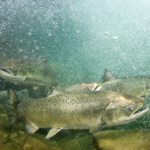The wallpaper should be high -quality and practical in operation, with their help you can create a spectacular original interior and give the house additional comfort.
The main tasks of decorating walls with wallpaper:
zone space;
visually increase or decrease space;
focus on, or make niches and protrusions invisible;
balance the light of the room;
raise or lower the ceiling;
hide small wall defects;
How to achieve the desired effect
1. Combination. Combine the main type of wallpaper with another, for example, it can be a separate wall or part of the room. Materials amaze with their diversity.
Testing: paint, decorative plaster, mirrors, cork, bamboo canvas, frescoes, plastic panels, etc.
Color: wallpapers of the same type, but of different color palettes: pistachio and pale yellow, green and pink, you can combine plain textured wallpaper with a strip or plant ornament.
Horizontal separation of walls: usually a strip or plain wallpaper from above and a saturated ornament from below, the horizon is separated by a border in tone. To decorate the lower part of the room, various panels, wooden sheathing, etc. are also used.
Inserts: walls are glued with discreet wallpaper and focusing, inserting brighter and dense materials, processing the edges with a baguette or decorative rail.
2. We break the geometry of space. This technique requires a thorough study of parts.
Using mirrors: the most powerful technique that can change space to recognition. Mirrors are combined both with dark wallpaper, making space and light wallpaper, visually increasing the room by several times.
Contrast: Combining pastel colors with dark or bright saturated shades. Such wallpaper options with wallpaper not only focus on a certain part of the room, but also make it possible to clearly distinguish between the space into the zones.
3. Lines: competent use of vertical and horizontal strips, geometric pattern, sticker of different wallpapers with a patchwork method of patchwork emphasize all the advantages of the room and hide the shortcomings.
4. Accents: columns, niches, portals, part of the wall, protrusions are highlighted with a very contrasting color with a common palette of wallpaper, thereby directing attention to some specific elements.
5. Decorating: The most popular option is murals, this technique can be adjusted to the volume of space, increase or reduce the room with colors and drawings, create microclimate and mood.
Trends in a modern interior
Wallpaper production technologies are echoing with modern fashion trends, their capabilities are used endlessly in interior design. Even the most common space with wallpaper is transformed into a stylish interior.
Wallpaper imitating gilding and velvet is an excellent solution for a luxurious palace style, classic and elegance always outside of fashion trends.
For the current retro design today, avant-garde colorful drawings, large figures, peas and a brightly expressed texture of the wallpaper are actively used.
Eco -style at the peak of popularity. To create such an interior, wallpaper made of natural materials are used: bamboo, stems, papers with dried flowers, trees bark, reeds, flowers, jute fibers, rattan, palm threads and peel of tropical plants.
The ultramodern style of the room can be created by gluing wallpaper with embossing, holographia, mother -of -pearl or matte.
The main rule in creating a new and fashionable interior is to remember that it will surround you for a year; certain design knowledge, an attentive approach to the choice of wallpaper will help to give the premises a respectable appearance.
Types
A wide range of textures and colors, aesthetic qualities, price range, simplicity and convenience of gluing – advantages that allow wallpaper to remain always in fashion.
The most popular for today:
Classic paper wallpapers are made of thick paper. Divided into subtypes: structural, embossed, smooth and murals.
Practical washing wallpaper. Two -layer, base – non -woven or thick paper, the top layer is polyvinyl chloride. Vinyl is subdivided according to the texture of the coating: silk -up, heavy and foamy vinyl, flat flat vinyl.
Textile multi -layer wallpaper: the upper layer of the tissue, the base is paper, fabric or synthetic materials.
Non -woven – cellulose material imitating paper. Two -layer material with polymer coating.
Liquid wallpaper – dry mixture that is mixed with water to a certain consistency and applied to the walls.
Fiberglass, based on a fiberglass impregnated with a special solution.
Metal. Porous paper with a thin layer of aluminum decorative foil is not covered with electrical wire paint, then embossing or pattern is applied.
The design solution is affected not only by time and fashion, but the character, lifestyle of a person, his addiction, etc. The species variety of wallpaper, stickers and stylistic techniques make up the basic base and help create the desired atmosphere.



